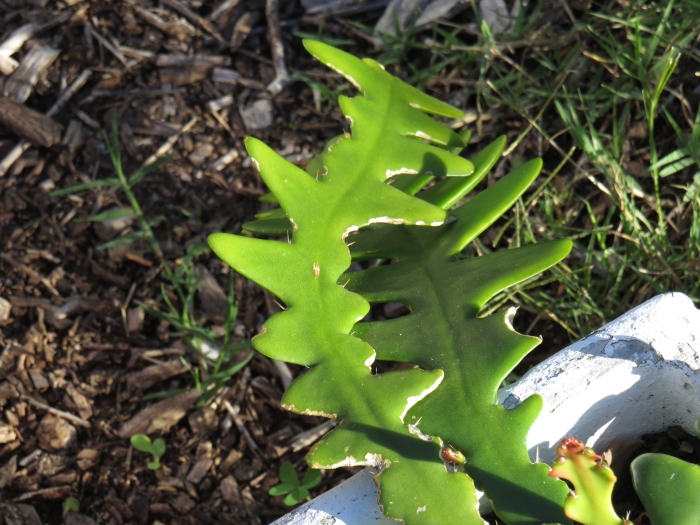Fishbone Cactus
(Selenicereus anthonyanus)
Fishbone Cactus (Selenicereus anthonyanus)
/
/

© Jeremy Gilmore
CC BY 4.0
Image By:
© Jeremy Gilmore
Recorded By:
Copyright:
CC BY 4.0
Copyright Notice:
Photo by: © Jeremy Gilmore | License Type: CC BY 4.0 | License URL: http://creativecommons.org/licenses/by/4.0/ | Uploader: jeremygilmore | Publisher: iNaturalist |



















Estimated Native Range
Summary
Selenicereus anthonyanus, commonly known as Fishbone Cactus, is an epiphytic cactus native to the tropical rainforests of southern Mexico, where it grows on trees or rocks in a humid environment. This species is particularly adapted to the dappled light of the forest understory. It is a perennial herb that can reach several meters in length, with flat, deeply lobed stems that resemble a fish’s skeleton, hence the common name. The nocturnal flowers of the Fishbone Cactus are large, fragrant, and cream-colored with distinctive purple bracts, blooming for a single night to attract nocturnal pollinators such as bats and moths.
The Fishbone Cactus is valued for its unique, ornamental foliage and its spectacular, albeit short-lived, blooms. It is often grown as a houseplant or in greenhouses, where its trailing habit makes it suitable for hanging baskets. In cultivation, it requires a humus-rich compost, semi-shade to mimic its natural habitat, and good air circulation. While it prefers high humidity, it is also important to allow the soil to dry out between waterings to prevent root rot. It is relatively easy to propagate from cuttings, making it accessible for many gardeners. Potential problems include overwatering, which can lead to root diseases, and insufficient light, which may reduce flowering.CC BY-SA 4.0
The Fishbone Cactus is valued for its unique, ornamental foliage and its spectacular, albeit short-lived, blooms. It is often grown as a houseplant or in greenhouses, where its trailing habit makes it suitable for hanging baskets. In cultivation, it requires a humus-rich compost, semi-shade to mimic its natural habitat, and good air circulation. While it prefers high humidity, it is also important to allow the soil to dry out between waterings to prevent root rot. It is relatively easy to propagate from cuttings, making it accessible for many gardeners. Potential problems include overwatering, which can lead to root diseases, and insufficient light, which may reduce flowering.CC BY-SA 4.0
Plant Description
- Plant Type: Succulent
- Height: 1.5-3 feet
- Width: 2-4 feet
- Growth Rate: Moderate
- Flower Color: Pink, Red, White
- Flowering Season: Spring, Summer
- Leaf Retention: Evergreen
Growth Requirements
- Sun: Full Sun, Part Shade
- Water: Low, Medium
- Drainage: Fast
Common Uses
Butterfly Garden, Low Maintenance, Potted Plant, Showy Flowers
Natural Habitat
Tropical rainforests
Other Names
Common Names: Zigzag Cactus
Scientific Names: , Selenicereus anthonyanus, Cryptocereus anthonyanus,
GBIF Accepted Name: